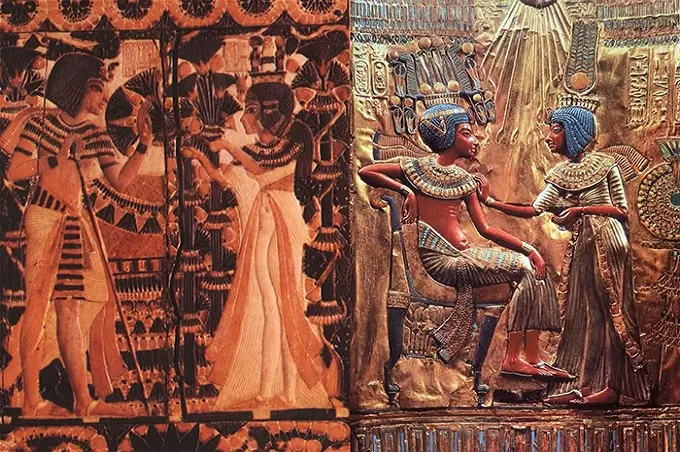A huge number of mysteries are connected with the era of the reign of Amenhotep IV, who lived about 3 thousand years ago and is better known as Akhenaten.
To this day, historians do not know why this pharaoh started such a large-scale religious reform, built a new capital, and why his images are so different from the images of his predecessors and successors … In addition, the insanely beautiful love story of Akhenaten and his wife, the legendary beauty Nefertiti, is still admired, although fate treated them extremely cruelly…
Nefertiti was the daughter of the king of the state of Mitanni, the country of the Aryans, where there was a cult of sun worship. The young beauty was sent to the harem of Pharaoh Amenhotep III. It was a purely political union, which had no continuation. Historians say that the princess at that time was only eleven years old. The girl was brought to the Egyptian city of Thebes and given the name Nefertiti, which means “the beauty is coming.”
The future Amenhotep IV at that time was twelve. He became very friendly with Nefertiti. Time passed, and Akhenaten’s father died, and his son took his place on the throne. The foreign beauty was inherited by him. After the wedding, the pharaoh forgot about all the women in the world. He saw before him only his beautiful wife.
large-scale reform
The era of the reign of Akhenaten and Nefertiti was called the “Amarna period”, based on the name of the modern city in Central Egypt, Tell el-Amarna. It is there where the ruins of the ancient capital of Egypt – the city of Akhetaten, which was built by Amenhotep IV, are located. The city was named after the sun god Aten. His cult tried to enter the pharaoh during his reign. Perhaps this reform was intended to unite Egypt under the rule of a single god. Amenhotep IV changed the entire royal title and even his personal name. Now he began to be called Akhenaten – “Pleasant to the Aten.”
The main blow of the reform fell on the hitherto dominant state cult of the god Amon. His name was removed from the monuments, and all images were ruthlessly destroyed. The new cult infinitely increased the power of the pharaoh. Moreover, he gave divine status to all members of Akhenaten’s family. Nefertiti began to be portrayed everywhere with befitting royal and divine attributes.
Tragic end
Everything seemed to be going great, until a certain time. Suddenly, one of the daughters of the spouses died, and then the mother of the pharaoh. No one knows exactly what happened to Akhenaten after this, but after these tragic events, for some reason, he sharply became preoccupied with a male heir. The fact is that Nefertiti gave him six children – and they were all girls. It can be said that the pharaoh was mad because he entered into an affair with two of his daughters. Only then in Egypt were incestuous relationships in the order of things. Ironically, the daughters gave birth to their father more daughters.
Then the desperate Amenhotep IV for the first time in the years of marriage, turned his attention to the harem. A concubine named Kiya gave birth to two long-awaited sons to the pharaoh at once – Smenkhkare and Tutankhaten (who, after ascending the throne, became the well-known Tutankhamun). After that, Akhenaten moved with his new wife and children to the new capital of Egypt, built on his orders. Nefertiti was exiled to a country house. The proud queen could not endure such a blow of fate. Historians believe that she killed a rival.
In 2010, two previously unknown mummies were examined. Scientists did a DNA analysis, which showed that one mummy belonged to Tutankhamun’s father, and the second to his mother. Moreover, the woman’s body was severely mutilated. At first, it was thought that this was done by tomb robbers, but studies have proven that the injuries were intravital. It is obvious that Kiya was brutally murdered. After this, Amenhotep IV himself died, and Smenkhkare reigned. He, too, soon died under mysterious circumstances.
After the elimination of all rivals on the Egyptian throne, Nefertiti reigned. Most scholars tend to think that she was not even a regent under the minor Tutankhaton, but the supreme ruler. What happened next is shrouded in mystery. One thing is clear, despite all her political influence and high status, the queen failed to keep power in her hands. The priests of Amon began to strengthen their influence again.
Nefertiti disappears somewhere. No one knows whether she was exiled or killed. The queen’s body has not been found to this day, either. After this, Tutankhaten reigns, who was married to the third daughter of Akhenaten and Nefertiti named Ankhesenpaaten. The new pharaoh cancels the reform of his father, and Egypt again returns to the worship of the god Amon. The ruler changes his name and the name of his wife. Now they are: Tutankhamun, “Living likeness of Amon,” and Ankhesenamun, “She lives for Amon.”
The reign of the spouses did not last long – only six years. All the time the pharaoh twisted as he wanted, his great-uncle Eye. The young pharaoh died under very mysterious circumstances. There are no heirs left. His wife bore him only two stillborn daughters. The throne was taken by Aye, who quickly married the widow of his great-nephew. He also did not last long in power. The former commander of Tutankhamen Horemheb overthrew him and reigned himself. Scientists have not yet figured out where Ankhesenamun disappeared. None of them left behind heirs. Thus ended the reign of the 18th dynasty.
In the eyes of historians, Tutankhamun long remained a little-known and insignificant ruler. Some even doubted its existence. The discovery of the tomb of this pharaoh at the beginning of the 20th century put an end to the disputes.
